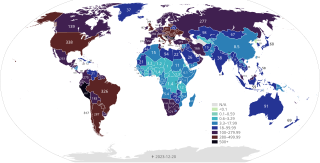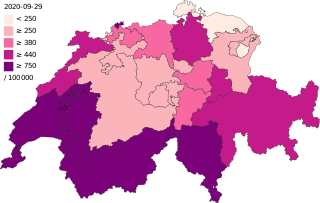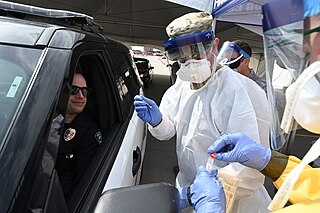
The Centers for Disease Control and Prevention (CDC) is the national public health agency of the United States. It is a United States federal agency under the Department of Health and Human Services, and is headquartered in Atlanta, Georgia.
Alexis Madrigal is an American journalist. He's currently the new co-host of KQED's Forum.

The COVID-19 pandemic, also known as the coronavirus pandemic, is a global pandemic of coronavirus disease 2019 (COVID-19) caused by severe acute respiratory syndrome coronavirus 2 (SARS-CoV-2). The novel virus was first identified in an outbreak in the Chinese city of Wuhan in December 2019. Attempts to contain it there failed, allowing the virus to spread to other areas of Asia and later worldwide in 2020. The World Health Organization (WHO) declared the outbreak a public health emergency of international concern (PHEIC) on 30 January 2020. The WHO ended its PHEIC declaration on 5 May 2023. As of 21 October 2023, the pandemic had caused 771,407,061 cases and 6,972,139 confirmed deaths, ranking it fifth in the deadliest epidemics and pandemics in history.

This is a general overview and status of places affected by severe acute respiratory syndrome coronavirus 2 (SARS-CoV-2), the virus which causes coronavirus disease 2019 (COVID-19) and is responsible for the COVID-19 pandemic. The first human cases of COVID-19 were identified in Wuhan, the capital of the province of Hubei in China in December 2019.

In the United States, the worldwide pandemic of coronavirus disease 2019 (COVID-19) caused by severe acute respiratory syndrome coronavirus 2 (SARS-CoV-2) has resulted in 103,436,829 confirmed cases with 1,136,920 all-time deaths, the most of any country, and the 20th-highest per capita worldwide. The COVID-19 pandemic ranks first on the list of disasters in the United States by death toll; it was the third-leading cause of death in the U.S. in 2020, behind heart disease and cancer. From 2019 to 2020, U.S. life expectancy dropped by 3 years for Hispanic and Latino Americans, 2.9 years for African Americans, and 1.2 years for white Americans. These effects persisted as U.S. deaths due to COVID-19 in 2021 exceeded those in 2020, and life expectancy continued to fall from 2020 to 2021.

The COVID-19 pandemic in Switzerland is part of the worldwide pandemic of coronavirus disease 2019 caused by severe acute respiratory syndrome coronavirus 2. The virus was confirmed to have spread to Switzerland on 25 February 2020 when the first case of COVID-19 was confirmed following a COVID-19 pandemic in Italy. A 70-year-old man in the Italian-speaking canton of Ticino which borders Italy, tested positive for SARS-CoV-2. The man had previously visited Milan. Afterwards, multiple cases related to the Italy clusters were discovered in multiple cantons, including Basel-City, Zürich, and Graubünden. Multiple isolated cases not related to the Italy clusters were also subsequently confirmed.

The COVID-19 pandemic in California began earlier than in some other parts of the United States. Ten of the first 20 confirmed COVID-19 infections in the United States were detected in California, and the first infection was confirmed on January 26, 2020. All of the early confirmed cases were persons who had recently travelled to China, as testing was restricted to this group, but there were some other people infected by that point. A state of emergency was declared in the state on March 4, 2020. A mandatory statewide stay-at-home order was issued on March 19, 2020; it was ended on January 25, 2021. On April 6, 2021, the state announced plans to fully reopen the economy by June 15, 2021.
The COVID-19 pandemic in Djibouti was a part of the worldwide pandemic of coronavirus disease 2019 caused by severe acute respiratory syndrome coronavirus 2. The virus spread to Djibouti in March 2020. It is a novel infectious disease caused by severe acute respiratory syndrome coronavirus 2. Model-based simulations for Djibouti indicate that the 95% confidence interval for the time-varying reproduction number R t has been rising since August 2020 and exceeded 1.0 until April 2021.

The COVID-19 pandemic in Benin was a part of the ongoing worldwide pandemic of coronavirus disease 2019 caused by severe acute respiratory syndrome coronavirus 2. The virus was confirmed to have reached Benin in March 2020.

The COVID-19 pandemic in North Dakota is an ongoing viral pandemic of coronavirus disease 2019 (COVID-19), a novel infectious disease caused by severe acute respiratory syndrome coronavirus 2 (SARS-CoV-2). The state reported its first case on March 11, 2020.

This article contains the monthly cumulative number of deaths from the pandemic of coronavirus disease 2019 (COVID-19) reported by each country, territory, and subnational area to the World Health Organization (WHO) and published in WHO reports, tables, and spreadsheets. There are also maps and timeline graphs of daily and weekly deaths worldwide.

Nancy Messonnier is an American physician who served as the director of the National Center for Immunization and Respiratory Diseases at the Centers for Disease Control and Prevention from 2016 to 2021. She worked on the CDC's response to the COVID-19 pandemic in the United States.

The COVID-19 pandemic has strongly impacted the journalism industry and affected journalists' work. Many local newspapers have been severely affected by losses in advertising revenues from COVID-19; journalists have been laid off, and some publications have folded. Many newspapers with paywalls lowered them for some or all of their COVID-19 coverage. The pandemic was characterized as a potential "extinction event" for journalism as hundreds of news outlets closed and journalists were laid off around the world, advertising budgets were slashed, and many were forced to rethink how to do their jobs amid restrictions on movement and limited access to information or public officials. Journalists and media organizations have had to address new challenges, including figuring out how to do their jobs safely and how to navigate increased repression and censorship brought on by the response to the pandemic, with freelancers facing additional difficulties in countries where press cards or official designations limit who can be considered a journalist.

The wearing of non-medical face masks in public to lessen the transmission of COVID-19 in the United States was first recommended by the CDC on April 3, 2020, as supplemental to hygiene and appropriate social distancing. Throughout the pandemic, various states, counties, and municipalities have issued health orders requiring the wearing of non-medical face coverings — such as cloth masks — in spaces and businesses accessible to the public, especially when physical distancing is not possible.

Ruth Link-Gelles is an American epidemiologist. She works for the United States Centers for Disease Control and Prevention (CDC) and serves as a Commander in the United States Public Health Service Commissioned Corps.
COVID-19 testing in the United States can identify whether a person is infected with SARS-CoV-2, the virus which causes COVID-19. This helps health professionals ascertain how bad the epidemic is and where it is worst. The accuracy of national statistics on the number of cases and deaths from the outbreak depend on knowing how many people are being tested every day, and how the available tests are being allocated.

The CDC publishes official numbers of COVID-19 cases in the United States. The CDC estimates that, between February 2020 and September 2021, only 1 in 1.3 COVID-19 deaths were attributed to COVID-19. The true COVID-19 death toll in the United States would therefore be higher than official reports, as modeled by a paper published in The Lancet Regional Health – Americas. One way to estimate COVID-19 deaths that includes unconfirmed cases is to use the excess mortality, which is the overall number of deaths that exceed what would normally be expected. From March 1, 2020, through the end of 2020, there were 522,368 excess deaths in the United States, or 22.9% more deaths than would have been expected in that time period.
The COVID-19 pandemic in the Federated States of Micronesia is part of the ongoing worldwide pandemic of coronavirus disease 2019 caused by severe acute respiratory syndrome coronavirus 2. The virus has reached the Federated States of Micronesia on 8 January 2021.
The UCLA Law COVID Behind Bars Data Project is an initiative of the UCLA School of Law that tracks the spread and impact of the COVID-19 pandemic in American prisons, immigration detention centers, jails, and youth detention facilities. Using custom web-scraping programs that automatically collect time-series, facility-level data reported by government agencies, the Project collects and reports data including the numbers of cases, deaths, tests, and vaccination rates among both incarcerated people and staff in more than 1,700 carceral facilities from more than 100 online sources.












